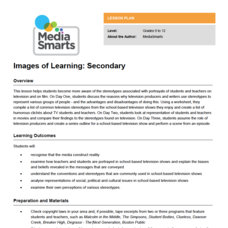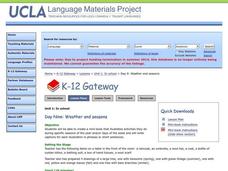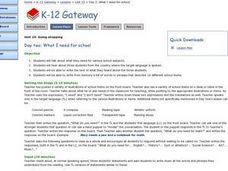Curated OER
Tintin and I: Primary and Secondary Sources
Mickey Mouse, Elmo, and Tintin? Belgian cartoonist Georges (Herge) Remi’s famous comic character launches a study of primary and secondary source material and the impact these sources have on storytelling. Class members also examine the...
Curated OER
Mondrian - Primary/Secondary Color Study
Utilizing computer software, learners demonstrate the color spectrum. They investigate the life of the artist Piet Mondrian and define his style of artwork. Then they use Photoshop to recreate some of his designs while discovering the...
Curated OER
Charles Darwin Meets John Paul II
If you teach AP English language and composition and are looking for a way to address the differences between written and spoken arguments, consider this lesson. Over the course of three days, class members research Charles Darwin or...
Curated OER
Learning Secondary Colors
Learners identify secondary colors. In this visual arts instructional activity, students predict what color will be made when two colors are mixed. Learners create their own painting using secondary colors and write about their...
Media Smarts
Images of Learning: Secondary
Make your scholars more aware of stereotypical portrayals in film and television. Discuss the definition of "stereotypes" and how they are used to present a story. High schoolers look at specific television shows and complete a chart...
Curated OER
Assessing Research Materials
Teaching learners how to evaluate a research source is an important part of the research process. The fresh idea here is that groups first develop a list of reasons why resources should be evaluated, transform these reasons into...
Curated OER
The Art and Science of Impressionist Color
Discover Impressionist painting as students investigate the 19th century combinations of colors characteristically used. Students experiment with their own paintings, utilizing primary and secondary colors.
Curated OER
Writing a Newspaper-Style Article
Help your secondary reader/writers assess texts by studying press releases from Statistics Canada and drafting articles based on them. They then compare the press release, their own articles, and actual news stories they find online. I'd...
Curated OER
Hear Ye, Hear Ye: Read All About It!
Develop an online newspaper covering the Lewis and Clark Expedition. The class publishes their newspaper on the school's Web site and analyze both primary and secondary sources.
Curated OER
Social Studies Wonders: An Exploration
Help middle schoolers conduct Internet research and develop a working definition for the discipline of social studies. From a list of websites, they develop classification skills and differentiate between primary and secondary sources....
Curated OER
Red is the Word!
Through the use of stories, artwork, and the KidPix program, youngsters explore the color word red, and engage in activities around the word. Teaching kindergartners about the color words can be so much fun. This could be adapted for any...
Curated OER
Weather and Seasons
Use pictures and manipulatives to develop vocabulary with your beginning language learners. This plan can be used with foreign language learners (although you'll have to provide the vocabulary), English language learners, or a young...
Curated OER
What I need for School
You can use this lesson with English language learners, a young language arts class, or speakers of a foreign language. The phrases learned are I need and I don't need. The teacher collects several items around the room, and learners...
Curated OER
Understanding and Fighting Stereotypes through Words and Images
Use some provocative modern art to get your class considering stereotypes and the impact they have on us all. Your class will discuss the print art Indian Look-Alike by Melanie Yazzie and stereotypes in general before...
Curated OER
Color Mixing
First graders practice identifying primary and secondary colors by mixing paint. In this colors lesson, 1st graders utilize primary colored paint to mix and experiment with in order to create secondary colors. Students paint...
Curated OER
The Crittenden Conway Duel
Students explore primary and secondary sources. In this primary and secondary source lesson, students investigate a crime scene. Students search for evidence around the classroom and evaluate their findings. Students write a crime report...
Curated OER
Distinguishing Main and Secondary Details
Fourth graders read the passage Seven Great Summits and identify the main idea and main and secondary details. In this details lesson plan, 4th graders classify their details into 2 categories.
Curated OER
Let There Be Peace: Nobel Prize Winners
What is the Nobel Peace Prize? After they establish criteria for great leadership, secondary learners read a New York Times article about President Jimmy Carter's acceptance of the Nobel Peace Prize in 2002. Individuals research the...
Curated OER
UN's Millennium Goals
Whose responsibility is it to improve schools in developing countries? How does quality education affect my neighborhood? Questions of responsibility, whether global or local, form the heart of this lesson. Using the UN’s Millennium...
Curated OER
Exploring Neighborhoods through Art
Students explore neighborhoods. In this color and social studies cross-curriculum lesson plan, students listen to Harold and the Purple Crayon by Crockett Johnson, then compare and contrast neighborhoods. Students mix primary colors to...
Curated OER
Colors
Students explore various colors. They research information on the primary and secondary colors. Students research the colors of the rainbow and they create a picture of a rainbow using Kid Pix.
Curated OER
Design Life: Exploring Society Through Art
Introduce learners to the design elements and artifacts of interior environments in Victorian Canada (or any people and era you care to explore) based on artwork that represents their world. Your secondary social historians view the art...
Curated OER
Complementary Color Experiments
Students experiment with color mixing and differentiate between primary and secondary colors. They use their observational skills in visual experiments with complementary colors to gain an understanding of the interrelationships of art,...
Curated OER
Reporting on the 1920s
Use this roaring 1920s history lesson to have young writers research primary and secondary sources. They use their research to examine the events or famous public figures of the time period. Next, they imagine they're in the 1920s and...























